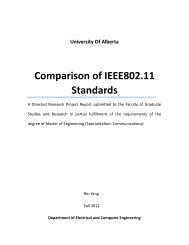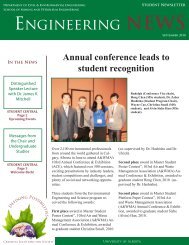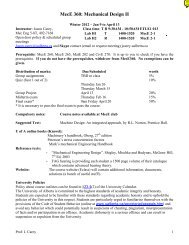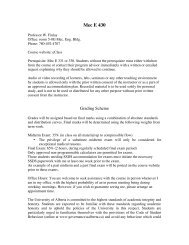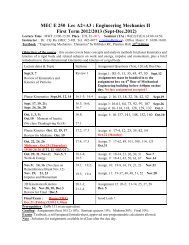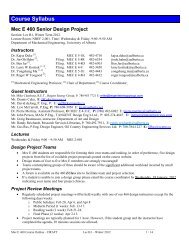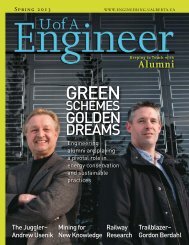Download - Faculty of Engineering - University of Alberta
Download - Faculty of Engineering - University of Alberta
Download - Faculty of Engineering - University of Alberta
Create successful ePaper yourself
Turn your PDF publications into a flip-book with our unique Google optimized e-Paper software.
Today’s development <strong>of</strong> the<br />
Athabasca oil sands is among the<br />
largest engineering projects in<br />
Canadian history. But, a generation<br />
ago, an energy development<br />
took place that was every bit as<br />
important for its contribution to<br />
the country’s economy and technological<br />
advancement.<br />
From the late 1960s through the early<br />
1990s, 22 Candu reactors were built in<br />
Ontario, Quebec, and New Brunswick to<br />
generate electricity. If they all were to be built<br />
today, Canada’s Candus could cost as much<br />
as $150 billion—an amount similar in scale<br />
to the investment currently contemplated for<br />
the <strong>Alberta</strong> oil sands.<br />
Like the oil sands, the Candu grew out <strong>of</strong><br />
a desire to exploit uniquely Canadian<br />
resources. Our fresh water yields heavy<br />
water: about one water molecule in 10,000<br />
carries deuterium (heavy hydrogen) atoms<br />
with an extra neutron. The Canadian Shield<br />
has substantial deposits <strong>of</strong> uranium, which in<br />
nature is more than 99 per cent U238; about<br />
0.7 per cent is the highly fissionable U235<br />
isotope. Canada had no desire to get into the<br />
production <strong>of</strong> enriched uranium, which could<br />
be used in nuclear weapons.<br />
What evolved out <strong>of</strong> necessity turned out<br />
to be “a fantastic system,” says Bob<br />
Hemmings (Chemical ’62). The Canadian<br />
deuterium uranium reactor technology was<br />
based on the principle <strong>of</strong> using heavy water<br />
to slow down the neutrons, permitting a controlled<br />
fission to be sustained using natural<br />
uranium fuel.<br />
Although the Candu’s roots date to<br />
wartime research at Chalk River, Ontario,<br />
development <strong>of</strong> the peacetime technology<br />
later branded CANDU began in earnest in<br />
1954. That year Ontario Hydro and Atomic<br />
Energy Canada Ltd. (AECL) joined eight<br />
other utilities, engineering, and manufacturing<br />
firms in a consortium to design and build<br />
reactors that were meant to be economically<br />
competitive with coal as a source <strong>of</strong> steam to<br />
generate electricity.<br />
As with the oil sands today, thousands <strong>of</strong><br />
Canadian engineers, including graduates from<br />
the <strong>University</strong> <strong>of</strong> <strong>Alberta</strong>, enjoyed rewarding<br />
careers in Canada’s nuclear industry. They<br />
worked on research reactors at Chalk River<br />
and in Whiteshell, Manitoba, and commercial<br />
generating stations at such places as<br />
Pickering, Ontario; Gentilly, Quebec; and<br />
Point Lepreau, New Brunswick. The opening<br />
in 1968 <strong>of</strong> a 220-megawatt power-generating<br />
unit at Douglas Point, Ontario, marked the<br />
beginning <strong>of</strong> commercial nuclear power in<br />
Canada. That took place one year after the<br />
first viable oil sands plant was up and running<br />
near Fort McMurray.<br />
Four decades later, both industries face<br />
similar challenges as they mature—high capital<br />
costs and serious concerns about environmental<br />
impacts—but in the go-go years<br />
around Canada’s centennial, optimism<br />
seemed limitless.<br />
Jim Saltvold (Electrical ’64) spent 39 years<br />
at AECL, mostly involved with research and<br />
development. He joined the industry in 1967,<br />
when many people in the industrialized world<br />
saw atomic energy as the thing <strong>of</strong> the future.<br />
“You felt there was prestige,” Saltvold<br />
recalls <strong>of</strong> his early days. “The glamour was still<br />
there, and there was still quite a bit <strong>of</strong> public<br />
support, but that diminished rather quickly.”<br />
Saltvold earned his master’s at the<br />
<strong>University</strong> <strong>of</strong> Wisconsin and worked in R&D<br />
at research reactors in Whiteshell and Chalk<br />
River, and raised a family in the company<br />
town <strong>of</strong> Pinawa, Manitoba, and at Deep<br />
River, Ontario. While at Whiteshell, Saltvold<br />
and his colleagues developed special-purpose<br />
instruments for use in reactors—“anything<br />
you couldn’t buy <strong>of</strong>f the shelf,” he explains.<br />
One was a device to measure internal friction<br />
in specimens <strong>of</strong> the metal used for reactor<br />
pressure tubes and fuel cladding, to study<br />
defects and their interaction. (Internal friction<br />
is what causes a vibrating flat spring to<br />
stop vibrating.) Another was an automated<br />
device to measure the diameter and pr<strong>of</strong>ile <strong>of</strong><br />
the pins in a fuel bundle that had been irradiated<br />
inside a reactor. The device dramatically<br />
reduced the amount <strong>of</strong> time that technicians<br />
needed to spend making these measurements<br />
by hand in heavily shielded containment<br />
boxes known as “hot cells.”<br />
Hemmings, who earned his PhD at the<br />
<strong>University</strong> <strong>of</strong> London, arrived at Whiteshell<br />
two years before Saltvold and worked with a<br />
company-wide team on a problem that<br />
plagued early reactors: the migration <strong>of</strong><br />
radioactive corrosion products within the<br />
reactor’s heavy-water core and light-water<br />
cooling systems. Tiny amounts <strong>of</strong> oxides<br />
Photo courtesy AECL<br />
would accumulate on uranium fuel, become<br />
radioactive, and then break away to build up<br />
again in undesirable places within the reactor’s<br />
zirconium guts. That buildup created extreme<br />
radiation levels in the boiler room at Douglas<br />
Point after only three years <strong>of</strong> operation.<br />
As a chemical engineer working on R&D<br />
at Whiteshell, Hemmings helped to identify<br />
the chemical bases that were used to create a<br />
decontamination system known as CANDE-<br />
CON®. That process used small concentrations<br />
<strong>of</strong> organic acids to dissolve the oxides,<br />
which were then removed from the water by<br />
a purification system. The system reduced the<br />
radiation problem at Douglas Point by a factor<br />
<strong>of</strong> six, and was employed in later Candu<br />
designs and marketed internationally.<br />
After two years on site for the commission-<br />
Workers at AECL’s Sheridan Park facility<br />
prepare for remote tooling development.<br />
ing <strong>of</strong> the Gentilly-1 reactor in Quebec,<br />
Hemmings moved during the early 1970s to<br />
the Toronto area, where most <strong>of</strong> AECL’s design<br />
work was going on in Mississauga, Ontario.<br />
There was never one Candu reactor;<br />
rather, over the decades a series <strong>of</strong> models<br />
evolved, each delivering more capacity and<br />
better performance. Hemmings worked on<br />
Ontario Hydro’s Pickering and Bruce projects<br />
before moving to Montreal in 1975 to open<br />
AECL’s new Candu-6 reactor design <strong>of</strong>fice.<br />
Later, he joined Canatom Ltd. (now part <strong>of</strong><br />
SNC-Lavalin) to continue to work on the<br />
design <strong>of</strong> Candu-6, a second-generation<br />
series. These were commissioned at Gentilly-<br />
2, Point Lepreau, and Darlington as well as<br />
Spring 2009 U <strong>of</strong> A Engineer 29




